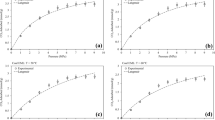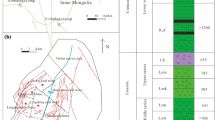Abstract
The current research investigates the kinetics of non-isothermal and isothermal pyrolysis of three different coal types (with different ash content) using the thermogravimetric (TGA) method in an argon atmosphere. The effect of mineral matter content on the pyrolysis characteristics was presented within the temperature range 600–1000 °C. The high ash coal sample used in the present study was collected from Talcher region, Orissa State, India. The coal sample was divided into three fractions (1.4, 1.6, 1.8) using the density separation technique to examine the effect of mineral matter or ash content on the coal pyrolysis during isothermal and non-isothermal heating. The results in the current study show that the mineral matter content helps in aiding the devolatilization rates in the pyrolysis process. Compared to the other coals, the 1.8 coal with a high ash content shows the maximum mass loss rate in the devolatilization range. The mass loss rate for the 1.4, 1.6, and 1.8 coals is found to be 1.2 μg/min, 1.2 μg/min, and 1.7 μg/min respectively. In isothermal conditions, the activation energies for 1.4, 1.6, and 1.8 is found to be 4.49 kJ/mol, 4.58 kJ/mol, and 12.5 kJ/mol, respectively.







Similar content being viewed by others
References
Behera S K, Chakraborty S, and Meikap B C, Int J Coal Sci Technol 5 (2018) 142.
Behera S K, Chakraborty S, and Meikap B C, Fuel 196 (2017) 102.
Mohanta S, and B C, Energy Sour, Part A: Recover, Util, Environ Eff 38 (2016) 1693.
Mohanta S, Chakraborty S, and Meikap B C, Ind Eng Chem Res 50 (2011) 10865.
Tripathy A, Biswal S K, and Meikap B C, Adv Powder Technol 27 (2016) 1488.
Baruah B P, and Khare P, Energy Fuels 21 (2007): 3346.
Raghuvanshi G, Chakraborty P, Hazra B, Adak A K, Singh P K, Singh A K, and Singh V, Int J Coal Prep Util (2020) 1.
Chavan P, Datta S, Saha S, Sahu G, and Sharma T, Sol Fuel Chem 46 (2012): 108.
Ahmad T, Awan I A, Nisar J, and Ahmad I, Energy Convers Manag 50 (2009) 1163.
Shi L, Qingya Q, Guo X, Wu W, and Liu Z, Fuel Process Technol 108 (2013) 125.
Khare P, Baruah B P, and Rao P G. Fuel 90 (2011): 3299.
Saida S, Chakravaty S, Sahu R, Biswas R D, and Chakravarty K. Trans o Indian Inst Met 73 (2020) 1257.
Shaik S, Chakravarty S, Mishra P R, Sahu R, Chakravarty K, Trans Indian Inst Met 72(2019) 3129.
Mishra P R, Sahu R, and Chakravarty S, Trans Indian Inst Met 73 (2020): 207.
[15] Banerjee A, Mishra P R, Mohanty A, Chakravarty K, Biswas R D, Sahu R, and Chakravarty S, Int J Coal Sci Technol 3 (2016): 97.
Khare P, and Baruah B P, Energy Sour, Part A: Recover, Util, Environ Eff 36 (2014) 774.
Veras C A G, Carvalho J A G, and Ferreira M A, J Braz Chem Soc 13 (2002): 358.
Liu Q, Haoquan H, Zhou Q, Zhu S, and Chen G. Fuel 83 (2004) 713
Zhou L, Zhang G, Reinmöller M, and Meyer B, Fuel 239 (2019) 1194.
Kosowska-Golachowska M, J Therm Sci 26 (2017): 355.
Wang C A, Zhang X, Liu Y, and Che D, Appl Energy 97 (2012) 264.
Solomon P R, Hamblen D G, Carangelo R M, Serio M A, and Deshpande G V, Energy & Fuels 2 (1988): 405.
Tokmurzin D, Ra H W, Yoon S M, Yoon S J, Lee J G, Seo M W, and Adair D. Int J Coal Prep Util (2019) 1.
Acknowledgements
The authors acknowledge and extend their sincere gratitude to the significant contribution and moral support provided by NIT Jamshedpur and CSIR-NML (Jamshedpur).
Author information
Authors and Affiliations
Corresponding author
Additional information
Publisher's Note
Springer Nature remains neutral with regard to jurisdictional claims in published maps and institutional affiliations.
Rights and permissions
About this article
Cite this article
Mishra, P.R., Sahu, R. & Chakravarty, S. Effect of Ash Content on the Pyrolysis of Indian Origin Coal. Trans Indian Inst Met 74, 2357–2366 (2021). https://doi.org/10.1007/s12666-021-02334-2
Received:
Accepted:
Published:
Issue Date:
DOI: https://doi.org/10.1007/s12666-021-02334-2




